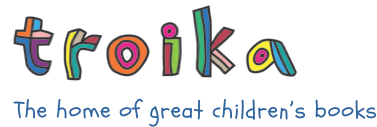"The book is about finding a home - in a big, epic way": author H.M. Bouwman on 'A Crack in the Sea'
American author H.M. Bouwman’s children’s novel A Crack in the Sea is published in the UK this month by Troika. We caught up with ‘H.M.’ (Heather), a professor of English at the University of St. Thomas, Minnesota, to chat about why she chose to focus on these themes, how issues inspired by American history are just as relevant to UK readers, and how teachers might use the book as a teaching resource.
Where fantasy and reality meet
The novel is a fantastical one that also incorporates real historical events. Three sets of siblings from very different times and places are catapulted into an adventure of a lifetime, thanks to a doorway between worlds which opens when least expected: the ‘crack in the sea’.
African twins Venus and Swimmer are captured aboard a slave ship bound for Jamaica in 1781. Thanh and Sang, who we meet in 1978, are on a small boat trying to escape post-war Vietnam when a storm and a pirate attack throw them off course. Meanwhile, orphaned siblings Kinchen and Pip live on an island in the Second World, until the King of Raftworld notices Pip’s special ability to communicate with fish and kidnaps him. What unites these six children is the urgent need to escape from oppression and find a sense of safety and home.
In the US, the book has been a finalist in a number of awards. Kirkus Review wrote, “This novel touches on sensitive and tragic moments in history and gives them fantastical remediation for a provocative, immersive read.” Booklist commented, “Bouwman weaves together these stories of freedom and escape with a deep sense of respect and emotion, bringing the reader directly into each family’s search for a safety that transcends both time and space.”
Themes of home and displacement
H.M. BOUWMAN: “Thematically, for me the book is about finding a home - in a big, epic way. It’s about groups of people who’ve been violently displaced from their homes trying to make their way in the world, and it’s about how groups of people who haven’t been violently displaced might welcome those people. (As a person who has never been violently displaced, I fit myself in that second camp.)
“In the US, in addition to the attempted genocide and removal of Native peoples, violent displacements have included the bringing of enslaved people to our shores and the arrivals of groups of refugees (some of them refugees because of American actions, as in the case of the Vietnam War). But what about the UK connections?
“The story of the character Venus connects explicitly to Britain’s history of involvement in the slave trade. In fact, the slave ship Zong is actually more closely connected to British than to American history. Although it was a Dutch ship, it was financed by a British consortium out of Liverpool, and the famous Zong trial took place in Britain and strongly influenced the British abolitionist movement. My hope is that UK educators can highlight that connection. (There was, some years ago, a recreated Zong slave ship that briefly sat in the harbour in London as a memorial, perhaps some readers may have visited.)
“The novel's connection between refugees and the UK is more by way of analogy, as the story focuses on Vietnamese refugees after the Vietnam War - still the most well-known refugee population in the US, I think, and a much smaller group in the UK. But when I drafted that section of the novel, images of Syrian refugees were showing up in the news; the photo of the drowned toddler in his red shirt and blue shorts was constantly in my mind as I was writing Thanh’s story. Fantasy operates by way of analogy and metaphor - one thing standing for another - and the metaphor’s meaning evolves as time passes. Readers today or ten years down the road might picture someone else or some other group of people as they read that section of the novel, and that makes sense.
A ‘complicated’ novel
Teaching guide
“The novel is also a complicated one for young readers: it’s multi-plotted, and the plots take place in two distinct time periods and with several different focus characters. One of the things I was trying to do here was teach emerging readers how to read a multi-plotted novel. The narrator is there to help them along -reminding them of characters, making some connections for them. I like to think I’m helping kids get ready to read Bleak House or Beloved or A Visit from the Goon Squad somewhere down the road. But at the same time, I wanted the book to be an adventure, to be engaging.
“With American teachers, I tend to emphasize the connections to curriculum (in this case, historical connections to slavery and the Vietnam war) and the ways in which this book is ‘challenging’ and might teach them about how fiction works (in this case, the multi-plotted novel).”



